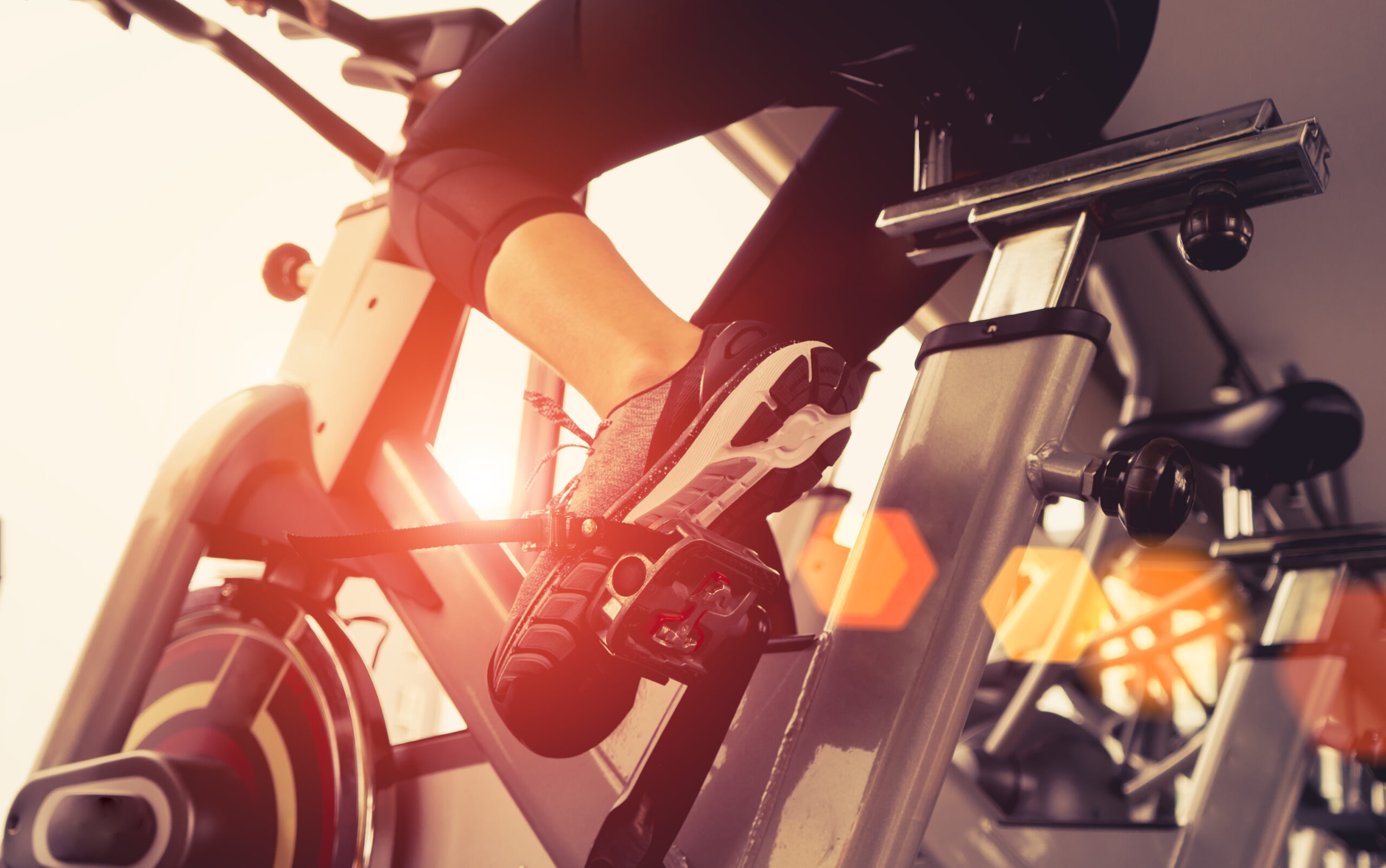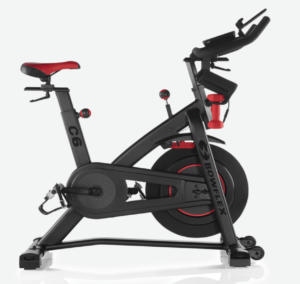The Bowflex C6 and the Schwinn IC4 are two of the hottest indoor cycles around these days.
And there’s really no mystery why: both bikes are packing impressive performance specs, come with advanced consoles, and are priced to move.
Both cycles also make great budget-friendly alternatives to Peloton, if you’re into that whole streaming thing (but unlike some streaming bikes, they work just fine without apps).
The question is- which one is better?
Well, that’s just the question I’m here to help you answer.
In this head-to-head review, I’ll compare these 2 impressive bikes with regards to all their key specs and features.
After reading, you’ll know once and for all which is the better buy.
Let’s begin.
| Bowflex C6 | Schwinn IC4 | |
|---|---|---|
| Resistance | 40 lb flywheel 100 levels of magnetic resistance | 40 lb flywheel 100 levels of magnetic resistance |
| Frame | 106 lb 330 lb weight capacity | 106 lb 330 lb weight capacity |
| Warranty | 10 year frame 3 year parts 1 year labor | 10 year frame 3 year parts 1 year labor |
| Features | LCD console Bluetooth connection with apps Heart rate monitor included Fully adjustable seat/handles | LCD console Bluetooth connection with apps Heart rate monitor included Fully adjustable seat/handles |
| Price | $999 | $999 |
The Bowflex C6 vs The Schwinn IC4
*above image courtesy of Bowflex
I wasn’t kidding in the intro there when I said these 2 bikes are equally matched. I might even go as far as saying these are 2 of the most evenly matched cycles around.
Not only are both bikes designed to do the same thing (pair with apps like Peloton), but they’re both priced identically (at the time of writing this anyway).
And, to take it one step further, both brands are owned by the same company.
Yup, Bowflex and Schwinn are both owned by Nautilus, Inc.
And yes, they own the Nautilus brand too.
Bowflex and Schwinn both come with impressive reputations, but generally speaking, I would say Bowflex tends to be a little higher-end.
The IC4 is one of Schwinn’s highest-end products to date, with really only their AC Performance Series cycles costing more.
Bowflex has plenty of machines that cost more than their C6– actually, when I think about it, the C6 is one of their most affordable products.
In order to keep this comparison as objective as possible, I’ll be comparing the specs/features these bikes have to offer against each other.
The bike that wins the most categories will when the battle.
Let’s start with the most important spec in my opinion, the resistance system.
Flywheel/Resistance
Both of these bikes are indoor cycles, meaning they both are designed to mimic the feel of riding a road bike.
Indoor cycles are well-known for their heavy flywheels, although the good folks at Keiser would argue they aren’t necessary.
Generally speaking, heavier flywheels are preferred because the extra weight builds more momentum, which in turn creates a smoother pedal motion.
Personally, I consider any bike packing at least a 20 lb flywheel to have a heavy flywheel, but these days you’ll find flywheels as heavy as 50 lb or more.
With all of this mind, let’s see how the flywheels on these 2 bikes compare:
The Bowflex C6 comes with a 40 lb flywheel and the Schwinn IC4 comes with a…40 lb flywheel as well.
Ok, so, these 2 bikes come with the same flywheel. Ok, no advantage either way there.
Let’s take a look at the resistance systems then.
Both bikes come with magnetic resistance systems, which is a great start. Most higher-quality spin bikes use magnetic systems because they provide a smoother resistance and you don’t have to worry about replacing a felt or leather friction brake.
When we look at the number of resistance levels each bike offers, that doesn’t make the decision any easier I’m afraid- both bikes come with 100 resistance levels.
And these are adjusted via a dial, just like the Peloton.
Which makes sense, considering both of these bikes are marketed as a cheaper alternative to the Peloton.
If you decide to sign up for Peloton’s Digital app (~$13/month), you can access all their classes without owning their equipment. You can use this app and one of these cheaper bikes to replicate the Peloton experience.
And since both of these bikes have the same number of resistance levels as the Peloton, it makes it a lot easier to follow along with the Peloton workouts.
Overall, both of these bikes come with identically heavy flywheels and identically impressive resistance systems. No advantage either way in this category.
Frame
Ok, the resistance department was a bit of a washout, but let’s move on to the frames.
It’s important for a spin bike to have a sturdy frame because you don’t want to feel like you’re wobbling or shimmying around during your workouts.
Especially when you’re standing and climbing those steeper hills.
I like to compare the assembled weights and the weight capacities because these 2 specs will give you an idea as to how heavy-duty the bikes are.
The C6 comes with an assembled weight of 106 lb and has a weight capacity of 330 lb.
The IC4 comes with an assembled weight of 106 lb and has a weight capacity of 330 lb.
Wow, ok, so these 2 bikes are identical in terms of frame capacity. I checked the dimensions of each and they both have the exact same dimensions as well.
I’m starting to get the feeling these 2 bikes are exactly the same, with only a paint job discerning the 2.
When it comes to the frame, these 2 bikes are identical again. No advantage either way.
Warranty
Moving on, let’s check out the warranties these bikes are offering. All other things equal, I say go with the better warranty.
Bowflex offers the following guarantee on their C6:
- 10 year frame
- 3 year parts
- 1 year labor
And Schwinn offers the following warranty on their IC4:
- 10 year frame
- 3 year parts
- 1 year labor
I guess I shouldn’t be surprised by this, but as you can see, these 2 warranties are the same.
And I have to say, both of these warranties are pretty generous for bikes in this price range (especially considering some of the more luxury models come with shorter guarantees).
Again, no advantage to either model.
Features
When it comes to performance specs, there are literally no differences between the C6 and the IC4. Let’s move on and take a look at the features each bike offers to see if there are any differences here.
Both of these bikes come with backlit, LCD consoles that display all the major cycling specs you’d expect. These include: time, speed, calories, distance, level (resistance), and pulse.
Neither bike provides an exact cadence reading, although they both have an RPM meter at the top that gives you an estimation of your cadence.
I’m not sure why neither bike thought it was important enough to display the cadence directly, considering this is one of the most important specs you need to follow along with Peloton workouts.
But, both bikes can connect with the Peloton digital app via bluetooth (as well as a handful of other apps) and when you do this, your cadence will show up on the app.
Both consoles allow you to set goals for the time, distance, or calories, where they will count down during your workout until you reach your set goal.
Both consoles are compatible with bluetooth heart rate monitors and both bikes include an armband monitor with purchase.
Both bikes come with tablet holders and USB charging ports as well.
Looking at these 2 bikes, it’s pretty evident they come with the exact same console- I don’t see a single difference between them besides the brand name that’s showing.
In terms of other features, both bikes come with fully adjustable seats, fully adjustable handlebars, and dual-compatible pedals (toe cage and SPD compatible clip-in).
Both bikes also include a set of 3 lb dumbbells (which are very handy for some of those Peloton workouts).
Overall, these 2 bikes are identical in terms of consoles and features.
Price
As you can probably guess, these 2 bikes are priced identically as well. At the time of writing this, both bikes come with an asking price of $999.
This is about half the price of the luxury spin bikes like Peloton or NordicTrack’s Commercial S22i.
And the nice thing about Peloton Digital, is that it only costs like $13/month- which is great compared to the $40 a month Peloton’s other subscription costs.
Keep in mind you can connect both bikes to a bunch of other fitness apps too.
I think both the C6 and the IC4 are fairly priced considering what you’re getting- heavy flywheels, 100 levels of resistance, sturdy frames, good warranties…
But once again, no advantage either way when it comes to price.
Other Considerations
I like to use this area for any other info I might wanna throw in the mix when comparing 2 bikes. This could be stuff like brand reputation, assembly, customer service, etc.
I don’t really have much to add here in this case.
Both of these bikes are coming from reputable brands and both brands are owned by the same company, so there really aren’t any big differences to consider here.
I will say, historically speaking, I tend to prefer Bowflex to Schwinn as a brand, for whatever that’s worth.
Final Thoughts
Ok, I think it’s about time to wrap this up.
By now, I think it’s pretty safe to say the Bowflex C6 and the Schwinn IC4 are the same bike.
Yes, they have different brand names painted on them, but both of these brands are owned by the same parent company and these 2 bikes are identical in every other manner.
These 2 bikes even have the same assembled dimensions.
But I’ve promised myself that I’d never finish one of these reviews with a tie and I’m not going to start now. So, when it comes to the Bowflex C6 vs the Schwinn IC4, the winner is…
The Bowflex C6
How’d I pick a winner if they’re both the same?
Well, I like the paint job on the C6 better, so I went with that one.
Hey, when all else fails, looks win.
Jokes aside, I don’t see any differences at all between these bikes. And I think either would make a great addition to any home gym.
But if I had to pick between them, I’d go with the Bowflex C6.






